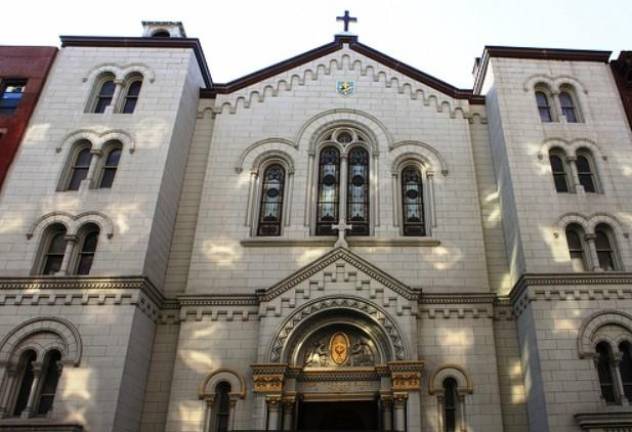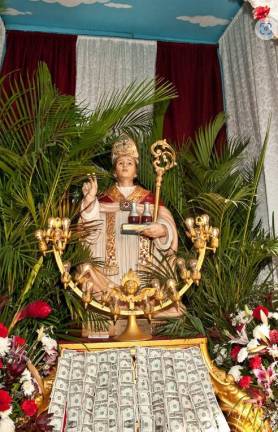Archdiocese Ends Merger of Historic Little Italy Church; But Is it Saved or Nearing the End?
Most Precious Blood, a 120-year-old church in Little Italy, has always held an important spot for Italian Americans and is at the center of the San Gennaro street festival each September. On Jan. 1, Cardinal Timothy Dolan said he was rescinding the nearly decade old merger of the parish into the Basilica of the Old St. Patrick Cathedral. But nobody is quite sure what is next. And on Jan. 11, the Friends of Most Precious Blood filed an objection to dissolving the merger.


Italian-Americans are wondering if Most Precious Blood, the 120-year-old church that houses the statue of San Gennaro that is at the center of one of the longest running street fairs in the United Statesd, has been saved after a ten year merger with another nearby parish was repealed on Jan. 1 by the Archdiocese of New York.
In a rare move, on Jan. 1 Cardinal Timothy Dolan signed a decree that rescinded the merger of Most Precious Blood into the parish of the Basilica of Old St. Patrick Cathedral that was made nearly ten years ago.
“The decree of merger of the territorial parish of the Basilica of Saint Patrick Old Cathedral, New York, and the personal parish of Most Precious Blood of November 2, 2014, is herewith rescinded,” Cardinal Dolan wrote in the Jan. 1 decree. “The office of pastoral planning is charged with the execution of this decree.”
But the Archdiocese has not communicated exactly what the repeal entails. “We really don’t know,” said John Fratta, who had recently formed the non-profit Friends of Most Precious Blood to try to raise money to repair and save the church.
He said some parishioners worry that the repeal decree is the first step toward eventually selling off the historic church property to a developer, the same fate that befell the one-time parish rectory on Mulberry St. about five years ago. That three story building and property was sold to a developer in 2018 and has been replaced by luxury condos.
One parishioner said the struggling Little Italy Church, at 113 Baxter St., received very little of the $14 million that was realized from the rectory selloff. “They paid for a new heating system and repaired the roof, but that was it,” said Fratta.
Fratta said he believes one parishioner filed a formal objection to the dissolution on Jan. 11 but he had no update on that.
“We still don’t have a pastor or an administrator and the Archdiocese hasn’t told us anything,” Fratta said.
The Archdiocese of New York spokesman Joe Zwilling said there is no sell off in the works. “The merger was rescinded because the two parishes were found to be non-complementary, or too different, for a successful merger. The two were never merged civilly, only canonically, so no civil court process is needed. Both Most Precious Blood and the Old Cathedral maintained separate books, and separate governance structures.”
Most Precious Blood itself was started in 1888 as a national parish to serve the teaming number of Italian immigrants arriving in New York. The actual church was started by the Scalabrini Order two years later with the aim of making it a national cathedral for Italian Americans, but the religious order ran out of funds and it fell to the Franciscans to complete the church in 1904. But the Franciscan order had to pull back from the parish in 2014, placing it under the care of the Archdiocese until Cardinal Dolan merged it into Old St. Patrick the following year.
What supporters of the parish were hoping was that a white knight was waiting in the wings to save the church and make repairs this time around.
Sixteen years ago there was an emotional battle in the East Village over the fate of the Church of St. Brigid, which was built by famine-era Irish in 1848 and which the Archdiocese wanted to shut down and sell to a developer. The wrecker’s ball was literally stopped in its tracks by a last minute restraining order and then saved when an anonymous donor stepped forward with a $20 million endowment to make structural repairs, shore up the finances of the church as well as its elementary school. The financing for the school ran out and as enrollment declined the Archdiocese closed the school in 2019. The former school is now being used as the migrant check-in center for asylum seekers who are applying for a new place to stay after getting the boot from city shelters after 30 days.
But Zwilling said there is no secret white knight in the wings. “There is no donor/endowment,” Zwilling said in an email.
Originally Cardinal Timothy Dolan announced back in November 2, 2014 that the Most Precious Blood parish was merging into the Basilica of Old St. Patrick Cathedral effective Aug. 15, 2015.
But that was all reversed by the New Year’s Day decree. “This decree is effective immediately,” Cardinal Dolan wrote but noted the decree had a ten day period to object. Fratta from the Friends of Most Precious Blood said he exercised that option on Jan. 11.
Father Enrique Salvo, the pastor of the Basilica of Old St. Patrick’s did not return several calls and an email. A call to the office of pastoral planning at the Archdiocese was not returned. The Most Precious Blood church is at 113 Baxter St. but also has an entrance on Mulberry St. in the heart of Little Italy.
”The parish is very important to a lot of Italian-Americans because it is where many of them started out in Little Italy when they first came to America,” he said.
He said he was told it was costing $100,000 a year just to maintain the building, which only holds one Mass on Sundays.
Fratta said the money from the San Gennaro Festival, at one time used to fund various charities, has in recent years been directed back to the combined parishes.
”There’s $50,000 sitting in a checking account from the San Gennaro Festival which used to go to Old St. Patrick’s,” Fratta said. “Now it could go to Most Precious Blood,” he said.